Fabrication of Bifacial-Modified Perovskites for Efficient Semitransparent Solar Cells with High Average Visible Transmittance
Abstract
1. Introduction
2. Results and Discussion
3. Materials and Methods
3.1. Materials
3.2. Device Fabrication
3.3. Characterization
4. Conclusions
Supplementary Materials
Author Contributions
Funding
Institutional Review Board Statement
Informed Consent Statement
Data Availability Statement
Conflicts of Interest
References
- Zhou, Z.; Yuan, Z.; Yin, Z.; Xue, Q.; Li, N.; Huang, F. Progress of semitransparent emerging photovoltaics for building integrated applications. Green Energy Environ. 2024, 9, 992–1015. [Google Scholar] [CrossRef]
- Mujahid, M.; Chen, C.; Zhang, J.; Li, C.; Duan, Y. Recent advances in semitransparent perovskite solar cells. InfoMat 2021, 3, 101–124. [Google Scholar] [CrossRef]
- Green, M.A.; Dunlop, E.D.; Yoshita, M.; Kopidakis, N.; Bothe, K.; Siefer, G.; Hao, X.; Jiang, J.Y. Solar cell efficiency tables (version 65). Prog. Photovolt. Res. Appl. 2024, 33, 3–15. [Google Scholar] [CrossRef]
- Han, J.; Park, K.; Tan, S.; Vaynzof, Y.; Xue, J.; Diau, E.W.-G.; Bawendi, M.G.; Lee, J.-W.; Jeon, I. Perovskite solar cells. Nat. Rev. Methods Primers 2025, 5, 3. [Google Scholar] [CrossRef]
- Cai, M.-G.; Watanabe, A.; Xu, Z.; Zhai, Y.-C.; Hidayat, A.S.; Ueoka, N.; Huda, M.; Higuchi, K.; Kauppinen, E.I.; Funabiki, K.; et al. Heptamethine cyanine dye-doped single-walled carbon nanotube electrodes for improving performance of HTL-free perovskite solar cells. Molecules 2025, 30, 60. [Google Scholar] [CrossRef]
- Lian, X.; Ma, Q.; Luo, M.; Min, H.; Fu, W.; Wan, L.; Zuo, X.; Wang, K.; Chen, Y.; Xu, C.; et al. Toward sustainable manufacturing of highly efficient and stable semi-transparent perovskite solar cells: The critical role of green solvent properties. Nano Energy 2024, 131, 110250. [Google Scholar] [CrossRef]
- Kim, S.-G.; Zhu, K. Chemical design of organic interface modifiers for highly efficient and stable perovskite solar cells. Adv. Energy Mater. 2023, 13, 2300603. [Google Scholar] [CrossRef]
- Mahmud, M.A.; Duong, T.; Peng, J.; Wu, Y.; Shen, H.; Walter, D.; Nguyen, H.T.; Mozaffari, N.; Tabi, G.D.; Catchpole, K.R.; et al. Origin of efficiency and stability enhancement in high-performing mixed dimensional 2D-3D perovskite solar cells: A review. Adv. Funct. Mater. 2022, 32, 2009164. [Google Scholar] [CrossRef]
- Fu, C.; Gu, Z.; Tang, Y.; Xiao, Q.; Zhang, S.; Zhang, Y.; Song, Y. From structural design to functional construction: Amine molecules in high-performance formamidinium-based perovskite solar cells. Angew. Chem. Int. Ed. 2022, 61, e202117067. [Google Scholar] [CrossRef]
- Li, B.; Deng, J.; Smith, J.A.; Caprioglio, P.; Ji, K.; Luo, D.; McGettrick, J.D.; Jayawardena, K.D.G.I.; Kilbride, R.C.; Ren, A.; et al. Suppressing interfacial recombination with a strong-interaction surface modulator for efficient inverted perovskite solar cells. Adv. Energy Mater. 2022, 12, 2202868. [Google Scholar] [CrossRef]
- Patil, P.; Kwon, S.-N.; Sangale, S.S.; Mann, D.S.; Na, S.-I. Oxysalt based synergistic dual interfacial engineering for high performance p–i–n structured perovskite solar cells. J. Mater. Chem. A 2023, 11, 26636–26648. [Google Scholar] [CrossRef]
- Shen, G.; Cai, Q.; Dong, H.; Wen, X.; Xu, X.; Mu, C. Using interfacial contact engineering to solve nickel oxide/perovskite interface contact issues in inverted perovskite solar cells. ACS Sustain. Chem. Eng. 2021, 9, 3580–3589. [Google Scholar] [CrossRef]
- Wang, Y.; Akel, S.; Klingebiel, B.; Kirchartz, T. Hole transporting bilayers for efficient micrometer-thick perovskite solar cells. Adv. Energy Mater. 2023, 14, 2302614. [Google Scholar] [CrossRef]
- He, X.; Chen, H.; Yang, J.; Wang, T.; Pu, X.; Feng, G.; Jia, S.; Bai, Y.; Zhou, Z.; Cao, Q.; et al. Enhancing hole transport uniformity for efficient inverted perovskite solar cells through optimizing buried interface contacts and suppressing interface recombination. Angew. Chem. Int. Ed. 2024, 63, e202412601. [Google Scholar] [CrossRef]
- Yi, Z.; Li, X.; Xiong, Y.; Shen, G.; Zhang, W.; Huang, Y.; Jiang, Q.; Ren Ng, X.; Luo, Y.; Zheng, J.; et al. Self-assembled monolayers (SAMs) in inverted perovskite solar cells and their tandem photovoltaics application. Interdiscip. Mater. 2024, 3, 203–244. [Google Scholar] [CrossRef]
- Jacobsson, T.J.; Correa-Baena, J.-P.; Pazoki, M.; Saliba, M.; Schenk, K.; Grätzel, M.; Hagfeld, A. Exploration of the compositional space for mixed lead halogen perovskites for high efficiency solar cells. Energy Environ. Sci. 2016, 9, 1706–1724. [Google Scholar] [CrossRef]
- Luan, F.; Li, H.; Gong, S.; Chen, X.; Shou, C.; Wu, Z.; Xie, H.; Yang, S. Precursor engineering for efficient and stable perovskite solar cells. Nanotechnology 2023, 34, 055402. [Google Scholar] [CrossRef]
- Lee, D.-K.; Jeong, D.-N.; Ahn, T.K.; Park, N.-G. Precursor engineering for a large-area perovskite solar cell with >19% efficiency. ACS Energy Lett. 2019, 4, 2393–2401. [Google Scholar] [CrossRef]
- Hu, S.; Wang, J.; Zhao, P.; Pascual, J.; Wang, J.; Rombach, F.; Dasgupta, A.; Liu, W.; Truong, M.A.; Zhu, H.; et al. Steering perovskite precursor solutions for multijunction photovoltaics. Nature 2025, 639, 93–101. [Google Scholar] [CrossRef]
- Teale, S.; Degani, M.; Chen, B.; Sargent, E.H.; Grancini, G. Molecular cation and low-dimensional perovskite surface passivation in perovskite solar cells. Nat. Energy 2024, 9, 779–792. [Google Scholar] [CrossRef]
- Wu, G.; Liang, R.; Ge, M.; Sun, G.; Zhang, Y.; Xing, G. Surface passivation using 2D perovskites toward efficient and stable perovskite solar cells. Adv. Mater. 2021, 34, 2105635. [Google Scholar] [CrossRef] [PubMed]
- Chang, X.; Azmi, R.; Yang, T.; Wu, N.; Jeong, S.Y.; Xi, H.; Utomo, D.S.; Vishal, B.; Isikgor, F.H.; Faber, H.; et al. Solvent-dripping modulated 3D/2D heterostructures for high-performance perovskite solar cells. Nat. Commun. 2025, 16, 1042. [Google Scholar] [CrossRef] [PubMed]
- Garai, R.; Sharma, B.; Afroz, M.A.; Choudhary, S.; Sharma, T.; Metcalf, I.; Tailor, N.K.; Iyer, P.K.; Mohite, A.D.; Satapathi, S. High-efficiency semitransparent perovskite solar cells enabled by controlling the crystallization of ultrathin films. ACS Energy Lett. 2024, 9, 2936–2943. [Google Scholar] [CrossRef]
- Dong, B.; Wei, M.; Li, Y.; Yang, Y.; Ma, W.; Zhang, Y.; Ran, Y.; Cui, M.; Su, Z.; Fan, Q.; et al. Self-assembled bilayer for perovskite solar cells with improved tolerance against thermal stresses. Nat. Energy 2025. [Google Scholar] [CrossRef]
- Gaspera, E.D.; Peng, Y.; Hou, Q.; Spiccia, L.; Bach, U.; Jasieniak, J.J.; Cheng, Y.-B. Ultra-thin high efficiency semitransparent perovskite solar cells. Nano Energy 2015, 13, 249–257. [Google Scholar] [CrossRef]
- Jiang, S.; Feng, L.; Zhang, W.; Liu, H.; Liu, H.; Liu, Y.; Li, B.; Wu, L.; Liu, X.; Wang, X.; et al. Indium-free flexible perovskite solar cells with AZO/Cu/Ag/AZO multilayer transparent electrodes. Sol. Energy Mater. Sol. Cells 2022, 246, 111895. [Google Scholar] [CrossRef]
- Zhou, Y.-P.; Ma, X.-Y.; Yang, P.-X.; He, Y.-L. Enhance and balance AVT and PCE of the semi-transparent perovskite solar cells for BIPV via grating-based photonic crystals. Mater. Today Chem. 2023, 30, 101520. [Google Scholar] [CrossRef]
- Giuliano, G.; Bonasera, A.; Arrabito, G.; Pignataro, B. Semitransparent perovskite solar cells for building integration and tandem photovoltaics: Design strategies and challenges. Sol. RRL 2021, 5, 2100702. [Google Scholar] [CrossRef]
- Zhou, L.; Chang, J.; Liu, Z.; Sun, X.; Lin, Z.; Chen, D.; Zhang, C.; Zhang, J.; Hao, Y. Enhanced planar perovskite solar cell efficiency and stability using a perovskite/PCBM heterojunction formed in one step. Nanoscale 2018, 10, 3053–3059. [Google Scholar] [CrossRef]
- Geng, C.; Zhang, K.; Wang, C.; Wu, C.H.; Jiang, J.; Long, F.; Han, L.; Han, Q.; Cheng, Y.-B.; Peng, Y. Crystallization modulation and holistic passivation enables efficient two-terminal perovskite/CuIn(Ga)Se2 tandem solar cells. Nano-Micro. Lett. 2025, 17, 8. [Google Scholar] [CrossRef]
- Bao, M.; Kong, F.; Liu, W.; Ghadari, R.; Gao, B. Enhanced performance of perovskite solar cells with multifunctional organic interface conditioner. Mater. Today Energy 2024, 46, 101726. [Google Scholar] [CrossRef]
- Shang, J.; Zhou, L.; Zhang, J.; Ge, H.; Chen, Q.; Zhang, Y.; Chen, D.; Zhu, W.; Xi, H.; Zhang, J.; et al. Dual-passivation strategy with escaped thiocyanate and sturdy chloride toward large-scale wide-band-gap perovskite modules. J. Phys. Chem. C 2024, 128, 6080–6088. [Google Scholar] [CrossRef]
- Chen, D.; He, Y.; Fan, G.; Zhang, Z.; Zhu, W.; Xi, H.; Zhou, L.; Zhang, C.; Zhang, J.; Hao, Y. Ultrahigh fill-factor all-inorganic CsPbBr3 perovskite solar cells processed from two-step solution method and solvent additive strategy. J. Mater. 2023, 9, 717–724. [Google Scholar] [CrossRef]
- Gillespie, S.C.; Gautier, J.; van der Burgt, J.S.; Anker, J.; Geerligs, B.L.J.; Coletti, G.; Garnett, E.C. Silicon-Inspired Analysis of Interfacial Recombination in Perovskite Photovoltaics. Adv. Energy Mater. 2024, 14, 2400965. [Google Scholar] [CrossRef]
- Le Corre, V.M.; Duijnstee, E.A.; El Tambouli, O.; Ball, J.M.; Snaith, H.J.; Lim, J.; Jan Anton Koster, L. Revealing Charge Carrier Mobility and Defect Densities in Metal Halide Perovskites via Space-Charge-Limited Current Measurements. ACS Energy Lett. 2021, 6, 1087–1094. [Google Scholar] [CrossRef]
- Zhou, L.; Lin, Z.; Ning, Z.; Li, T.; Guo, X.; Ma, J.; Su, J.; Zhang, C.; Zhang, J.; Liu, S.; et al. Highly Efficient and Stable Planar Perovskite Solar Cells with Modulated Diffusion Passivation Toward High Power Conversion Efficiency and Ultrahigh Fill Factor. Sol. RRL 2020, 3, 1900293. [Google Scholar] [CrossRef]
- Lim, S.H.; Seok, H.J.; Choi, D.H.; Kim, S.K.; Kim, D.H.; Kim, H.K. Room temperature processed transparent amorphous InGaTiO cathodes for semi-transparent perovskite solar cells. ACS Appl. Mater. Interfaces 2021, 13, 27353–27363. [Google Scholar] [CrossRef]
- Jung, J.W.; Chueh, C.C.; Jen, A.K.Y. High-performance semitransparent perovskite solar cells with 10% power conversion efficiency and 25% average visible transmittance based on transparent CuSCN as the hole-transporting material. Adv. Energy Mater. 2015, 5, 1500486. [Google Scholar] [CrossRef]
- Lim, S.H.; Seok, H.J.; Kwak, M.J.; Choi, D.H.; Kim, S.K.; Kim, D.H.; Kim, H.K. Semi-transparent perovskite solar cells with bidirectional transparent electrodes. Nano Energy 2021, 82, 105703. Available online: https://www.sciencedirect.com/science/article/pii/S2211285520312763 (accessed on 4 March 2025). [CrossRef]
- Yu, J.C.; Sun, J.; Chandrasekaran, N.; Dunn, C.J.; Chesman, A.S.; Jasieniak, J.J. Semi-transparent perovskite solar cells with a cross-linked hole transport layer. Nano Energy 2020, 71, 104635. [Google Scholar] [CrossRef]
- Ka, I.; Asuo, I.M.; Basu, S.; Fourmont, P.; Gedamu, D.M.; Pignolet, A.; Cloutier, S.G.; Nechache, R. Hysteresis-Free 1D Network Mixed Halide-Perovskite Semitransparent Solar Cells. Small 2018, 14, 1802319. [Google Scholar] [CrossRef] [PubMed]
- Rai, M.; Yuan, Z.; Sadhu, A.; Leow, S.W.; Etgar, L.; Magdassi, S.; Wong, L.H. Multimodal Approach towards Large Area Fully Semitransparent Perovskite Solar Module. Adv. Energy Mater. 2021, 11, 2102276. [Google Scholar] [CrossRef]
- Giuliano, G.; Cataldo, S.; Scopelliti, M.; Principato, F.; Chillura Martino, D.; Fiore, T.; Pignataro, B. Nonprecious Copper-Based Transparent Top Electrode via Seed Layer–Assisted Thermal Evaporation for High-Performance Semitransparent n-i-p Perovskite Solar Cells. Adv. Mater. Technol. 2019, 4, 1800688. [Google Scholar] [CrossRef]
- Bisconti, F.; Giuri, A.; Dominici, L.; Carallo, S.; Quadrivi, E.; Po, R.; Biagini, P.; Listorti, A.; Corcione, C.E.; Colella, S.; et al. Managing transparency through polymer/perovskite blending: A route toward thermostable and highly efficient, semitransparent solar cells. Nano Energy 2021, 89, 106406. [Google Scholar] [CrossRef]
- He, C.; Wang, J.; Chen, S.; Zhou, Y.; Jiang, N.; Zhang, J.; Duan, Y. Resolving the Contradiction between Efficiency and Transparency of Semitransparent Perovskite Solar Cells by Optimizing Dielectric-Metal-Dielectric Transparent Top Electrode. Sol. RRL 2023, 7, 2300126. [Google Scholar] [CrossRef]
- Cheng, F.; Cao, F.; Chen, B.; Dai, X.; Tang, Z.; Sun, Y.; Yin, J.; Li, J.; Zheng, N.; Wu, B. 85 °C/85%-Stable n-i-p Perovskite Photovoltaics with NiOx Hole Transport Layers Promoted By Perovskite Quantum Dots. Adv. Sci. 2022, 9, 2201573. [Google Scholar] [CrossRef]
- Zhang, Y.-W.; Cheng, P.-P.; Tan, W.-Y.; Min, Y. Balance the thickness, transparency and stability of semi-transparent perovskite solar cells by solvent engineering and using a bifunctional additive. Appl. Surf. Sci. 2021, 537, 147908. [Google Scholar] [CrossRef]
- Yang, Z.; Niu, Y.; Zhang, X.; Zhang, Z.; Hu, L. Efficiency improvement of semi-transparent perovskite solar cells via crystallinity enhancement. J. Mater. Chem. A 2023, 11, 3070–3079. [Google Scholar] [CrossRef]
- Yu, J.C.; Li, B.; Dunn, C.J.; Yan, J.; Diroll, B.T.; Chesman AS, R.; Jasieniak, J.J. High-Performance and Stable Semi-Transparent Perovskite Solar Cells through Composition Engineering. Adv. Sci. 2022, 9, 2201487. [Google Scholar] [CrossRef]
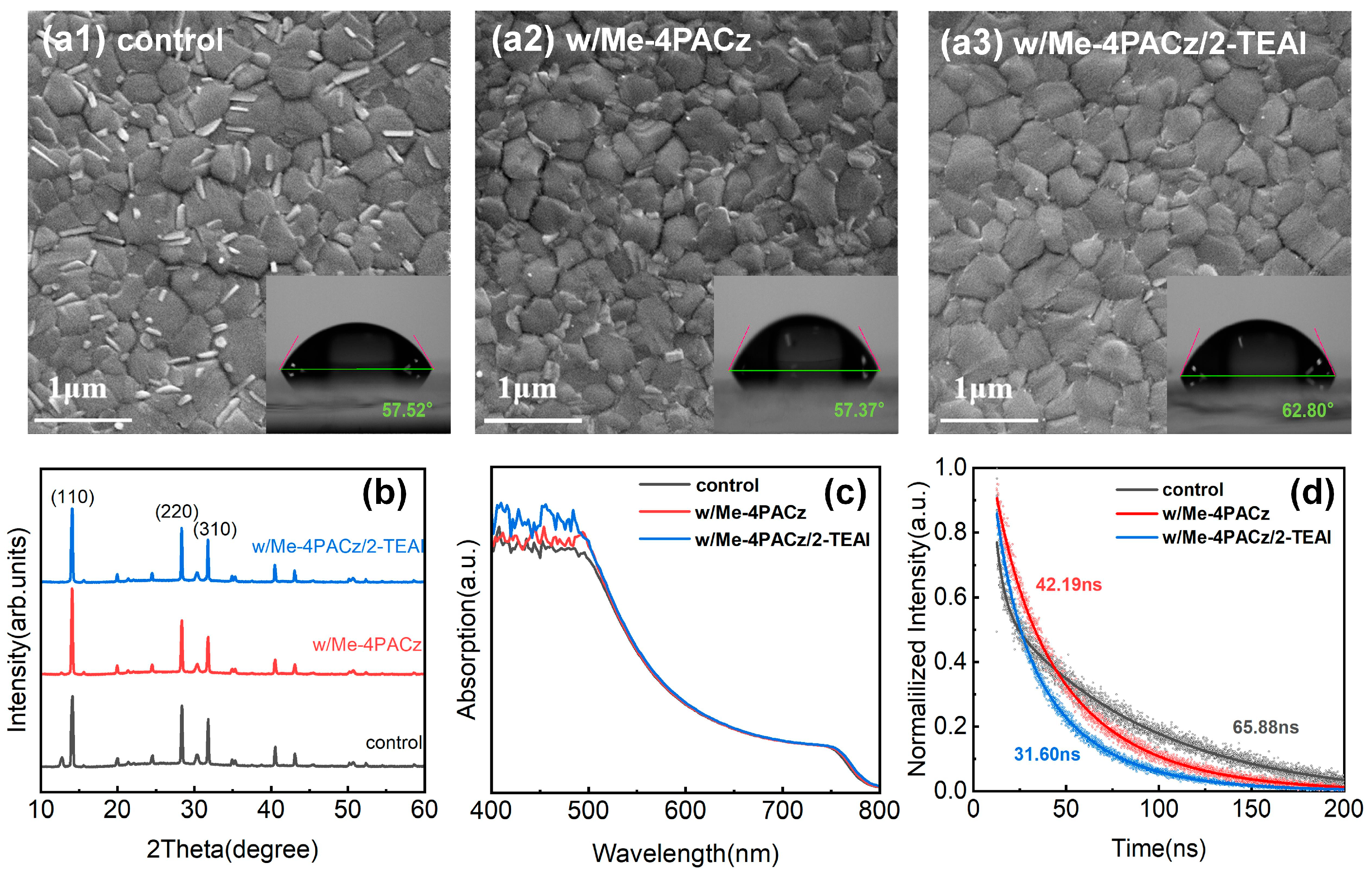
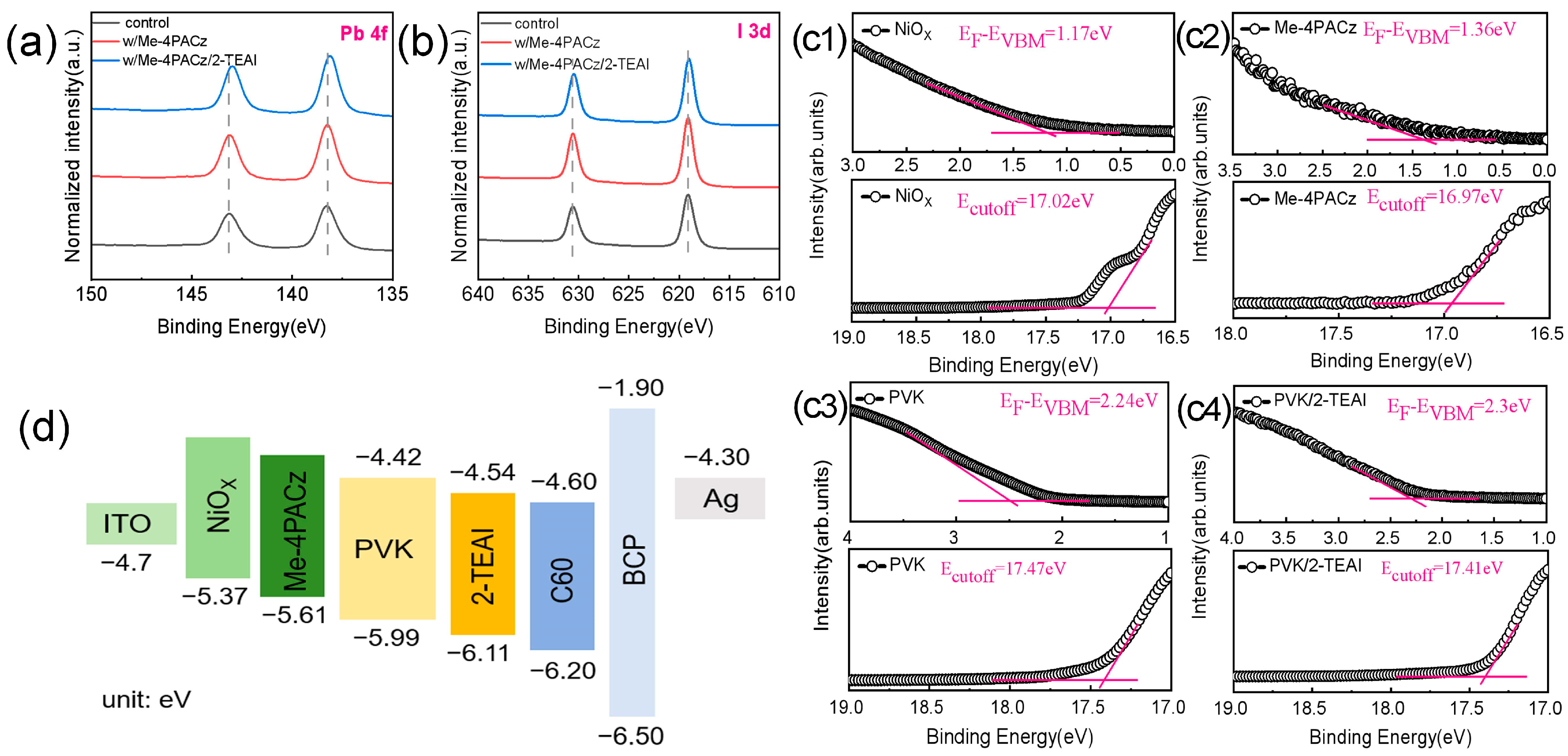
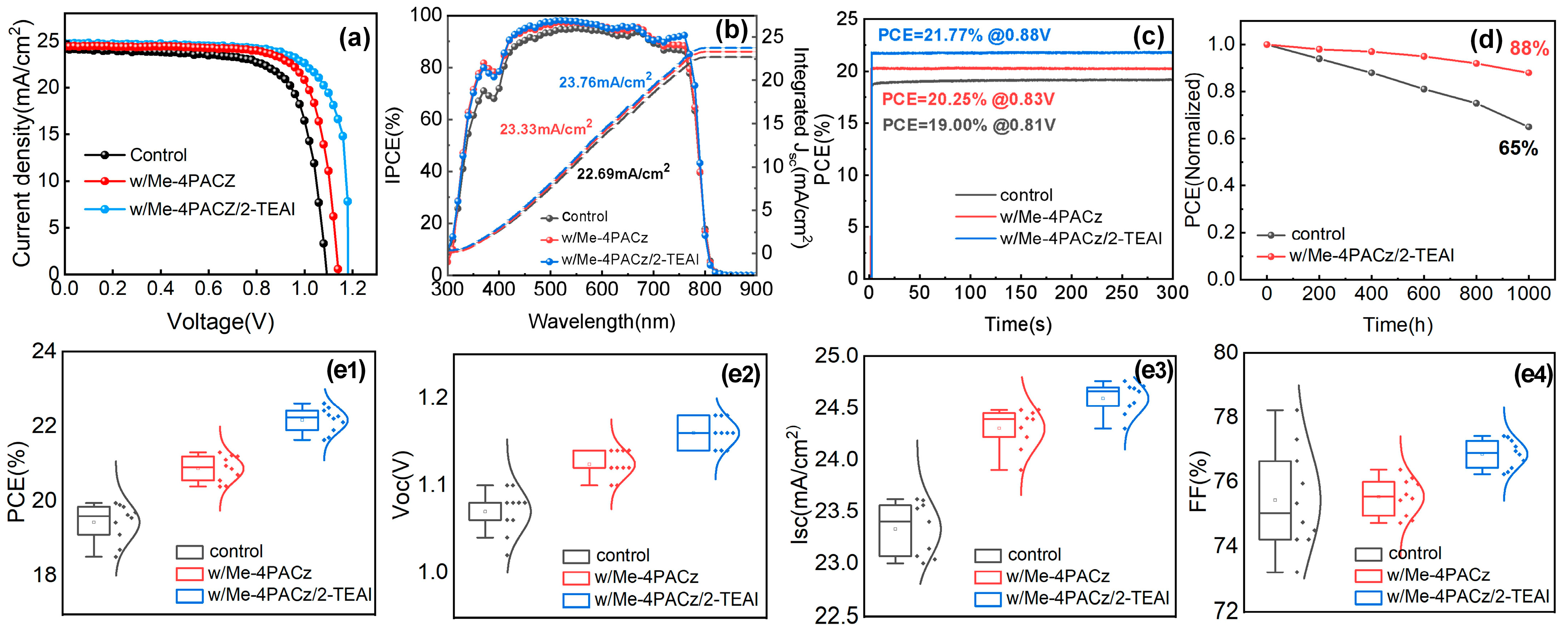
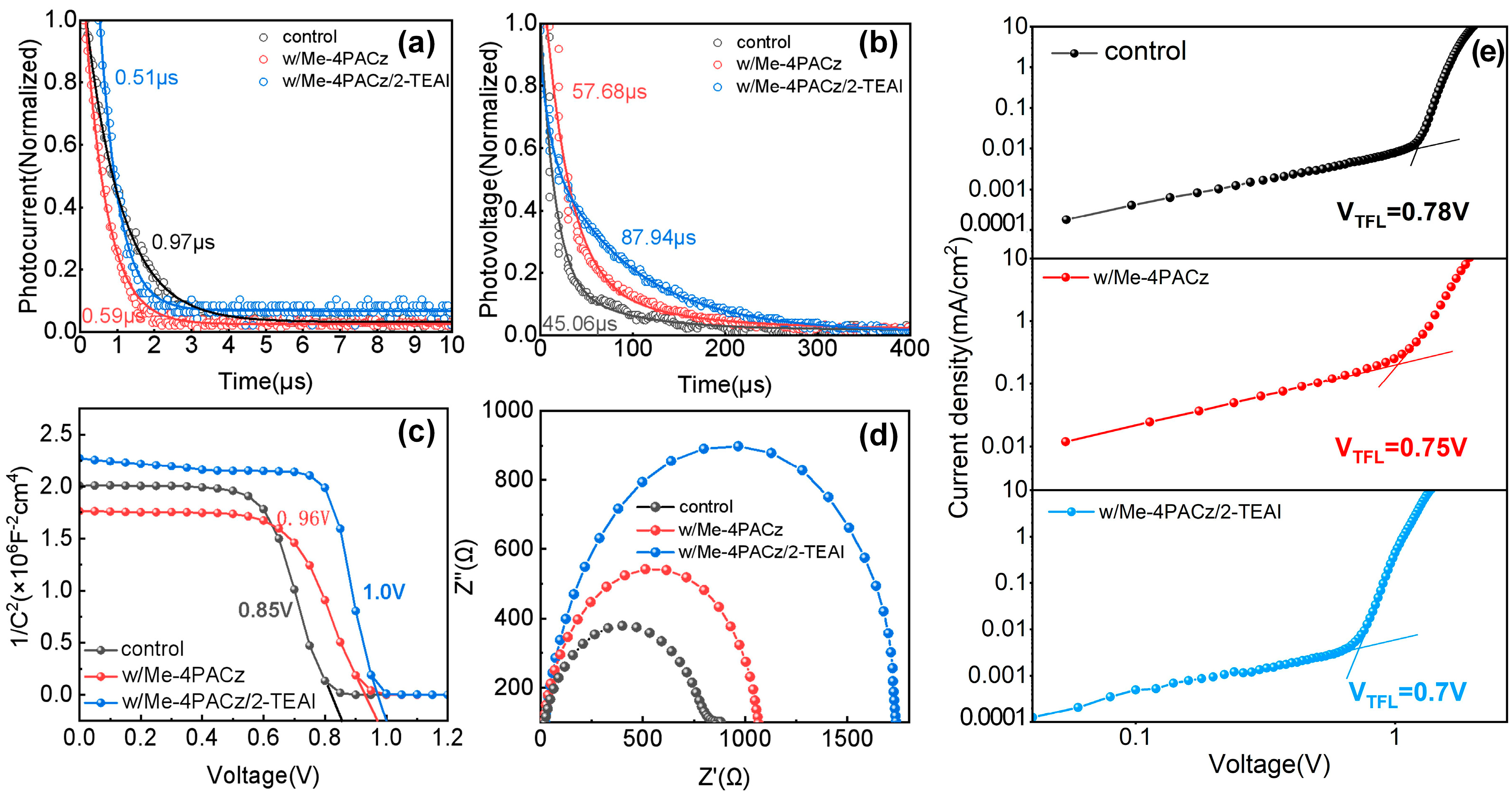
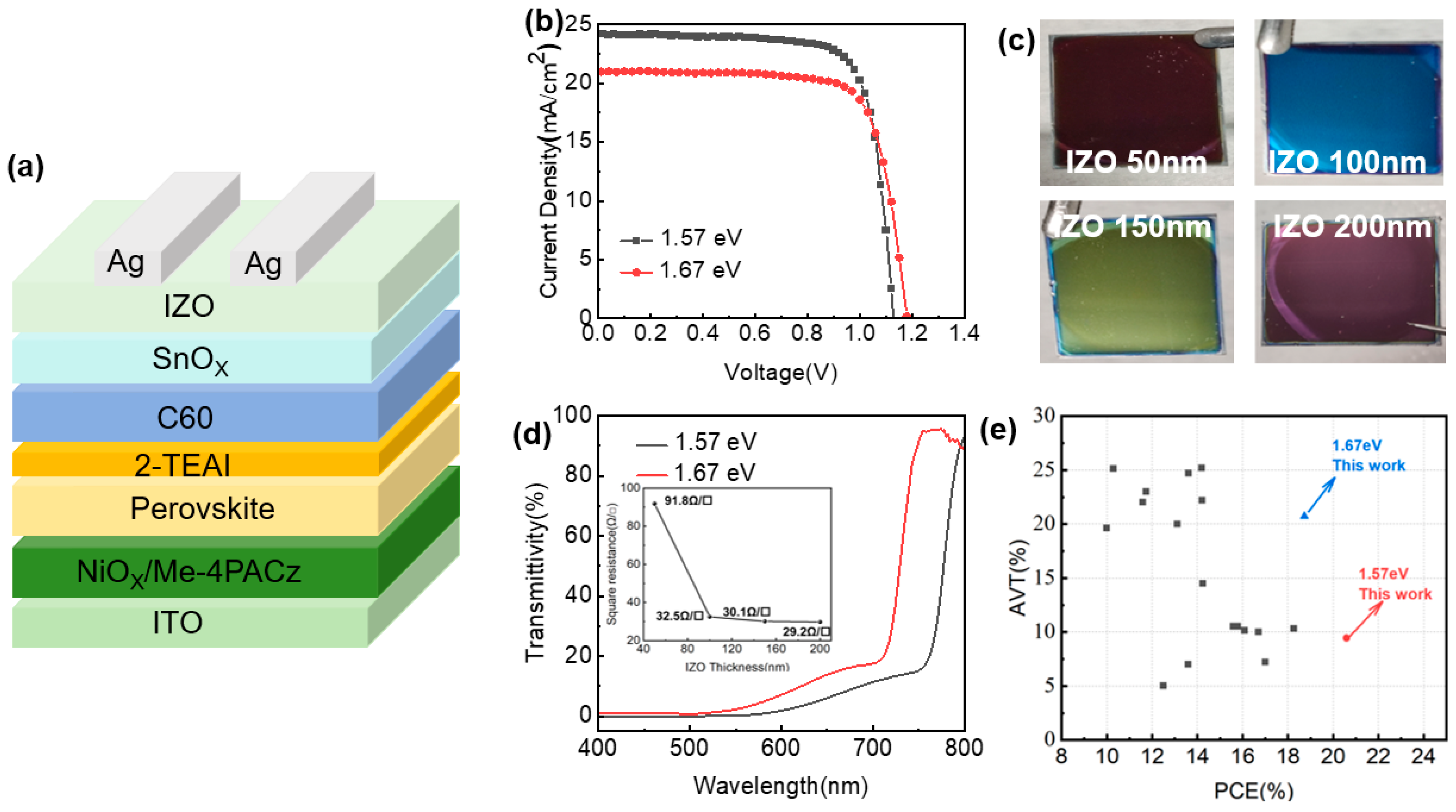
| Device | JSC (mA/cm2) | FF (%) | PCE (%) | AVT (%) | VOC (V) | |
|---|---|---|---|---|---|---|
| 1.57 eV-perovskite | Control | 24.16 | 73.68 | 19.23 | / | 1.08 |
| Me-4PACz | 24.48 | 76.38 | 21.31 | / | 1.14 | |
| Me-4PACz & 2-TEAI | 24.76 | 77.43 | 22.62 | / | 1.18 | |
| Semitransparent | 24.20 | 76.14 | 20.59 | 9.45 | 1.12 | |
| 1.67 eV-perovskite | Opaque | 21.71 | 77.80 | 20.26 | / | 1.20 |
| Semitransparent | 21.03 | 75.46 | 18.73 | 20.71 | 1.18 | |
Disclaimer/Publisher’s Note: The statements, opinions and data contained in all publications are solely those of the individual author(s) and contributor(s) and not of MDPI and/or the editor(s). MDPI and/or the editor(s) disclaim responsibility for any injury to people or property resulting from any ideas, methods, instructions or products referred to in the content. |
© 2025 by the authors. Licensee MDPI, Basel, Switzerland. This article is an open access article distributed under the terms and conditions of the Creative Commons Attribution (CC BY) license (https://creativecommons.org/licenses/by/4.0/).
Share and Cite
Chen, D.; Shi, W.; Gao, Y.; Wang, S.; Tian, B.; Wang, Z.; Zhu, W.; Zhou, L.; Xi, H.; Dong, H.; et al. Fabrication of Bifacial-Modified Perovskites for Efficient Semitransparent Solar Cells with High Average Visible Transmittance. Molecules 2025, 30, 1237. https://doi.org/10.3390/molecules30061237
Chen D, Shi W, Gao Y, Wang S, Tian B, Wang Z, Zhu W, Zhou L, Xi H, Dong H, et al. Fabrication of Bifacial-Modified Perovskites for Efficient Semitransparent Solar Cells with High Average Visible Transmittance. Molecules. 2025; 30(6):1237. https://doi.org/10.3390/molecules30061237
Chicago/Turabian StyleChen, Dazheng, Wenjing Shi, Yan Gao, Sai Wang, Baichuan Tian, Zhizhe Wang, Weidong Zhu, Long Zhou, He Xi, Hang Dong, and et al. 2025. "Fabrication of Bifacial-Modified Perovskites for Efficient Semitransparent Solar Cells with High Average Visible Transmittance" Molecules 30, no. 6: 1237. https://doi.org/10.3390/molecules30061237
APA StyleChen, D., Shi, W., Gao, Y., Wang, S., Tian, B., Wang, Z., Zhu, W., Zhou, L., Xi, H., Dong, H., Chai, W., Zhang, C., Zhang, J., & Hao, Y. (2025). Fabrication of Bifacial-Modified Perovskites for Efficient Semitransparent Solar Cells with High Average Visible Transmittance. Molecules, 30(6), 1237. https://doi.org/10.3390/molecules30061237









